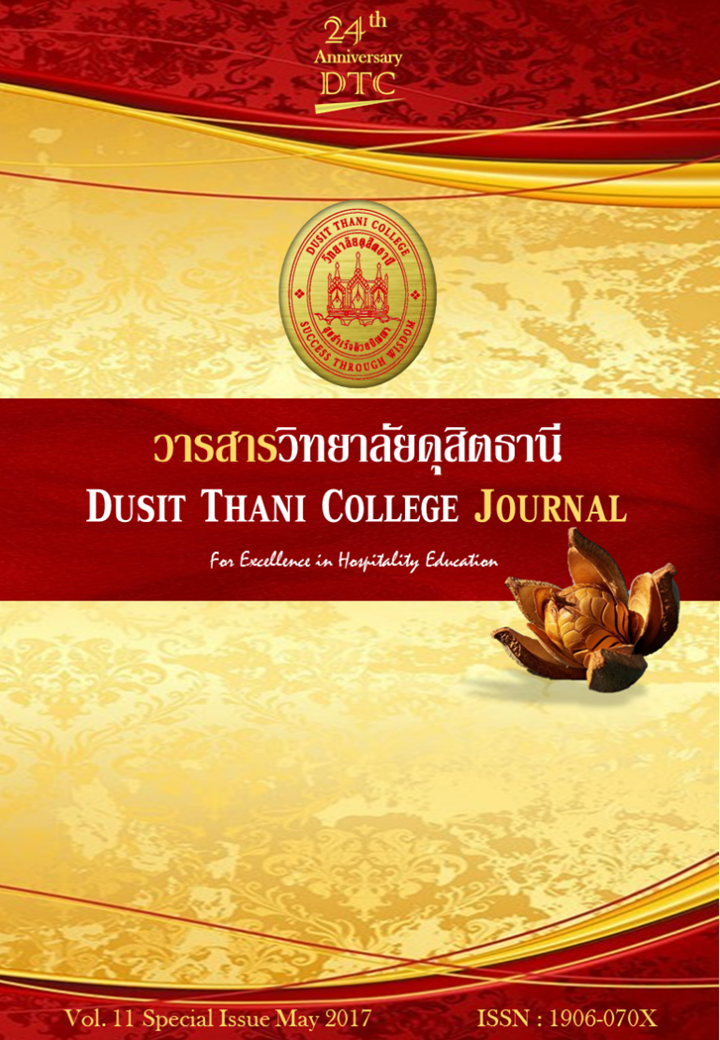วิวัฒนาการเครื่องแกงไทย
Main Article Content
บทคัดย่อ
ในงานวิจัยนี้ใช้การวิจัยเชิงคุณภาพทางวัฒนธรรมที่มีความมุ่งหมายเพื่อศึกษาประวัติความเป็นมาของเครื่องแกงไทยโดยใช้ภูมิปัญญาพื้นบ้านในเขตภาคกลาง คัดเลือกพื้นที่วิจัยแบบเจาะจงจากสถาบันอุดมศึกษา 3 แห่ง คือ โรงเรียนวิชาการโรงแรมแห่งโรงแรมโอเรียนเต็ล (หลักสูตรบริหารการครัวไทย) โรงเรียนการอาหารนานาชาติสวนดุสิต (หลักสูตรการฝึกอบรมช่างฝีมืออาหารไทย) และสถาบันเทคโนโลยีราชมงคล วิทยาเขตพระนครใต้ (หลักสูตรอาหารและโภชนาการ) กลุ่มตัวอย่างประกอบด้วย กลุ่มผู้รู้ด้านเครื่องแกงไทย 6 คน ผู้ปฏิบัติ 15 คน และกลุ่มบุคคลทั่วไป 170 คน เก็บรวบรวมข้อมูลด้วยวิธีการสังเกต การสัมภาษณ์ การประชุมกลุ่มย่อย การสนทนากลุ่ม และการประชุมเชิงปฏิบัติ ตรวจสอบความถูกต้องของข้อมูลด้วยเทคนิคสามเส้า นำเสนอผลการวิเคราะห์ข้อมูลโดยการพรรณนาวิเคราะห์ ผลการวิจัยพบว่า ความเป็นมาของเครื่องแกงไทยเกิดขึ้นในสมัยสุโขทัยในภูมิคาถา มีใช้วัตถุดิบที่มาจากแหล่งน้ำ มีการปลูกพืช ผัก และเครื่องเทศ มีการเลี้ยงสัตว์เพื่อนำมาประกอบอาหาร มีการใช้อุปกรณ์ในการปรุงอาหาร มีการนำเข้าอุปกรณ์ใส่อาหารจากประเทศจีน ในสมัยอยุธยามีการบริโภคแกงที่ใส่กะปิ มีส่วนผสมของสมุนไพร เครื่องเทศ และผักกลิ่นฉุน มีการบริโภคเนื้อสัตว์ วัตถุดิบที่มาจากแหล่งน้ำและทะเล โดยแกงบางชนิดได้รับอิทธิพลจากการประกอบอาหารจากจีน ญี่ปุ่น เปอร์เซีย ฝรั่งเศส มอญ โปรตุเกส อินเดีย และฮอลันดา เครื่องแกงไทยโบราณมักจะมีรสชาติตะไคร้และใบมะกรูดรวมกับกะทิ เครื่องเทศที่ใช้ในเครื่องแกงไทยขึ้นอยู่กับภูมิภาค อาหารไทยที่สร้างขึ้นจากเครื่องแกงเป็นที่นิยมทั่วโลก
Article Details
นโยบายการพิจารณากลั่นกรองบทความ
- บทความวิจัยและบทความวิชาการทุกเรื่องที่จะได้รับการตีพิมพ์ต้องผ่านการพิจารณากลั่นกรองโดยผู้ทรงคุณวุฒิ (Peer Review) ในสาขาที่เกี่ยวข้อง จำนวน 3 ท่าน/บทความ
- บทความ ข้อความ ภาพประกอบและตารางประกอบที่ลงตีพิมพ์ในวารสารเป็นความคิดเห็นส่วนตัวของผู้เขียน กองบรรณาธิการไม่จำเป็นต้องเห็นด้วยเสมอไป และไม่มีส่วนรับผิดชอบใด ๆ ถือเป็นความรับผิดชอบของผู้เขียนแต่เพียงผู้เดียว
- บทความที่จะได้รับการตีพิมพ์จะต้องไม่เคยตีพิมพ์ เผยแพร่ที่ใดมาก่อน และไม่อยู่ระหว่างการพิจารณาของวารสารฉบับอื่น หากตรวจสอบพบว่ามีการตีพิมพ์ซ้ำซ้อน ถือเป็นความรับผิดชอบของผู้เขียนแต่เพียงผู้เดียว
- บทความใดที่ผู้อ่านเห็นว่าได้มีการลอกเลียนหรือแอบอ้างโดยปราศจากการอ้างอิง หรือทำให้เข้าใจผิดว่าเป็นผลงานของผู้เขียน กรุณาแจ้งให้กองบรรณาธิการวารสารทราบจะเป็นพระคุณยิ่ง
References
Bradley, C. B. (1909). The Oldest known writing in Siamese; the inscription of Phra Ram Khamhaeng of Sukhothai, 1293 A.D. Journal of the Siam Society, 6(1): 5-68.
Bradley, D. B. (1906). Poket. Reprint from Dr. Bradley's Bangkok Calendar for 1871. Journal of the Siam Society, 3(1): 17-20.
Chotechuang, N. (2012). Taste active components in Thai foods: A review of Thai traditional seasonings. Journal of Nutrition & Food Sciences, S10: 004.
Cochrane, J. (Ed.). (2008). Asian tourism: Growth and change. Hungary: Elsevier.
Coedes, G. (1918). Notes critiques sur L'inscription de Rama Khamheng. Journal of the Siam Society, 12(1): 1-27.
Coedes, G. (1921). Siamese documents of the seventeenth century. Journal of the Siam Society, 14(2): 7-39.
Douglas, M., Heyes, J., & Smallfield, B. (2005). Herbs, spices and essential oils Post-harvest operations in developing countries. United Nations Industrial Development Organization, Austria: Institute for Crop and Food Research Inc.UNIDO and FAO.
Faithong, N., Benjakul, S., Phatcharat, S., & Binsan, W. (2010). Chemical composition and antioxidative activity of Thai traditional fermented shrimp and krill products. Food Chemistry, 119(1): 133-140.
Frankfurter, O. (1906). Some suggestions for romanizing Siamese. Journal of the Siam Society, 3(2): 52-61.
Gerini, G. E. (1904). On Siamese proverbs and idiomatic expressions. Journal of the Siam Society, 1: 11-168.
Goel, A., Kunnumakkara, A. B., & Aggarwal, B. B. (2008). Curcumin as "curecumin": from kitchen to clinic. Biochemical Pharmacology, 75(4): 787-809.
Grove, P., & Grove, C. (2010). The Flavours of history (From corn to chilli to curry). New York: Peter J Grove.
Hazarika, M. (2006). Neolithic culture of Northeast India: A recent perspective on the origins of pottery and agriculture. Ancient Asia, 1: 25-43.
Hazra, K. L. (1982). History of Theravāda Buddhism in South-East Asia with special reference to India and Ceylon. West Patel Nagar, New Delhi, India: Munshiram Manoharial Publishers Pvt. Ltd.
Hedge, I. C., & Lamond, J. M. (1992). Umbelliferae (Vol. 5). Bangkok: The Chutima Printing.
Hugh, T. W. T. (2005). Herbs and spices of Thailand. Singapore: Times Editions-Marshall Cavendish.
Jones, N. L., Shabib, S., & Sherman, P. M. (1997). Capsaicin as an inhibitor of the growth of the gastric pathogen Helicobacter pylori. FEMS Microbiology Letters, 146(2): 227-233.
Kanchanakunjara, T. (2008). The 20th Thai Cooking Demonstration: La Demostracion de la Cocina Tailandesa article. Retrieved from http://www.thaiembassychile.org/index.php?lay=show&ac=article&Id=538740388 &Ntype=1.
Kanchanakunjara, T. (2013). Thai curry paste: An application of indigenous knowledge based on a creative economy for exporting. Ph.D., Mahasarakham University, Mahasarakham Province.
Kanchanakunjara, T., Chantachon, S., Koseyayothin, M., & Kuljanabhagavad, T. (2014a). Research and development of traditional massaman curry paste and tom yum in central Thailand for the Western. Gastronomica, submitted.
Kanchanakunjara, T., Chantachon, S., Koseyayothin, M., & Kuljanabhagavad, T. (2014b). Use of indigenous knowledge in food processing and preservation of traditional curry paste recipes in central Thailand for global market. African Journal of Indigenous Knowledge Systems, submitted.
Koo, S. J., & Kim, H. S. (2005). Cultural foods in the world. Paju: Kyomoonsa.
Kuljanabhagavad, T., Sriubolmas, N., & Ruangrungsi, N. (2011). Chemical composition, antibacterial and antifungal activities of essential oil from Heracleum siamicum Craib. Pharmaceutical Chemistry Journal, 45(3): 178-182.
Kuljanabhagavad, T., Thongphasuk, P., Thongphasuk, J., & Wink, M. (2014). Effect of v-irradiation on bioactive chemical constituents and antioxidant activity of turmeric (Curcuma longa L.) rhizome. Radiation Physics and Chemistry, submitted.
Kulke, H., & Rothermund, D. (1998). A History of India (3rd ed.). Routledge, United State: Taylor & Francis.
Miquel, J., Bernd, A., Sempere, J. M., Dıaz-Alperi, J., & Ramırez, A. (2002). The curcuma antioxidants: pharmacological effects and prospects for future clinical use. A review. Archives of Gerontology and Geriatrics, 34(1): 37-46.
Mouritsen, O. G. (2012). Umami flavour as a means of regulating food intake and improving nutrition and health. Nutrition and Health, 21(1): 56-75.
Nakornriab, M., & Puangpronpitag, D. (2011). Antioxidant activities and total phenolic contents of Thai curry pastes. International Journal of Applied Chemistry, 7(2): 43-52.
Njomo, L. M. (2012). Satisfying the indigenous food needs of sub-Saharan African immigrants in South Africa: A food consumption behaviour model for South Africa’s leading supermarket chains. African Journal of Business Management, 6(25): 7557-7568.
Pelliot, P. (1959). Notes on Marco Polo (Vol. I). Paris, UK: Imprimerie Nationale Librarie Adrien-Maisonneuve.
Raghavan, S. (2007). Handbook of spices, seasonings, and flavorings (2 ed.). 6000 Broken Sound Parkway NW, Suite 300 Boca Raton, FL, US: CRC Press Taylor & Francis Group.
Rajadhon, A. (1988). Essays on Thai Folklore (3rd ed.). Bangkok: Thai Inter-Religious Commission for Development & Sathirakoses Nagapradipa Foundation. Kled Thai Co. and Suksit Siam.
Rajanubhab, D. H. R. H. (1914-15). The story of the records of Siamese history. Journal of the Siam Society, 11(2): 1-20.
Seah, R., Siripongvutikorn, S., & Usawakesmanee, W. (2010). Antioxidant and antibacterial properties in Keang-hleung paste and its ingredients. Asian Journal of Food and Agro-Industry, 3(2): 213-220.
Siripongvutikorn, S., Pengseng, N., Ayusuk, S., & Usawakesmanee, W. (2008). Development of green curry paste marinade for white shrimp (Litopenaeus vannamei). Songklanakarin Journal of Science and Technology, 30(1): 35-40.
Sirivejkul, N. (2003). Division of Historical Periods. Bangkok: MAC Printing Co., Ltd.
Wei, L. S., & Wee, W. (2013). Chemical composition and antimicrobial activity of Cymbopogon nardus citronella essential oil against systemic bacteria of aquatic animals. Iranian Journal of Microbiology, 5(2): 147-152.
Wright, M. (1992). Ayudhya and its place in pre-modern Southeast Asia. Journal of the Siam Society, 80(1): 81-86.
Wyatt, D. K. (1974). A Persian mission to Siam in the reign of King Narai. Journal of Siam Society, 62(1): 151-157.
Yoshida, Y. (1998). Umami taste and traditional seasonings. Food Reviews International, 14(2-3): 213-246.

